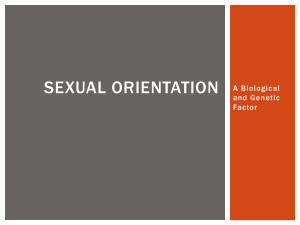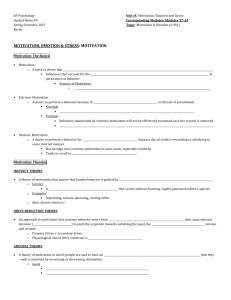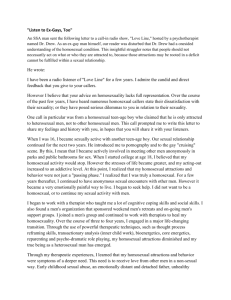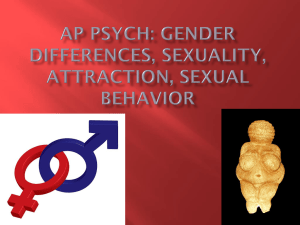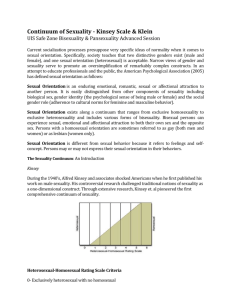Is there evidence for *gay* genes?
advertisement
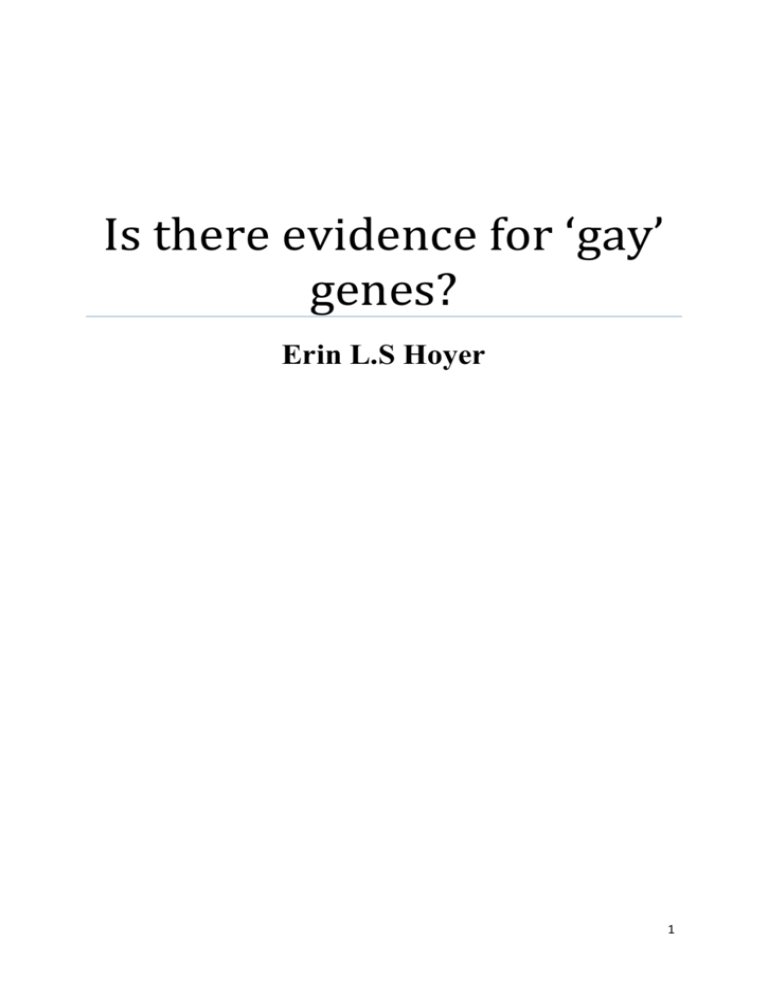
Is there evidence for ‘gay’ genes? Erin L.S Hoyer 1 Introduction Sexual orientation is a topic of discussion across biology, psychology and various other disciplines. The nature vs. nurture debate is prominent with regard to this topic and the debate usually centres on ‘What ‘causes’ homosexuality?’ At present, there is no concrete genetic basis for homosexuality in either male or female populations and research varies substantially between the sexes. In Australia, the prevalence of women identifying as exclusively homosexual is 0.8% (Smith et al. 2003). In male populations across Australia, the prevalence is varying such as 0.8%-3.0% (varying across states) and 1.6% (wholly across Australia) identify as exclusively homosexual (Prestage et al. 2008; Smith et al. 2003). Psychological and biological differences between homosexuals and heterosexuals have been presented in the scientific literature but whether or not these are genetically influenced or determined has not been thoroughly researched. The actual location(s) of gene(s) that may influence or determine homosexuality have not been discovered but there is evidence suggesting that genetic links may be present and whether the evidence is a product of environment or genetics is currently debated. The idea of a genetic determinant of sexual orientation stemmed from cumulating evidence of differences in brain structure, behaviour and brain function between male and female homosexuals and their heterosexual counterparts. But here lies a strain between genetic determinism, genetics shifting behaviour (genetic predisposition) and individual free will. As sexual orientation is a complex variation in humans, it would be wise to conclude that no one genetic marker will be linked to homosexuality. We currently do not have the whole picture of our genetic variance as humans and we remain far from identifying human genes (Camargo et al. 2001) and even more importantly, the functions of various proteins. By cataloguing genetic variance we may get closer to various biomarkers for certain traits. A recent estimate of greater than 1% 2 variation within an individual genome (Conrad et al. 2010) could support genetic variation having probable contributions to complex human traits. Scientific research becomes difficult in this field as the measurement of sexual orientation relies on psychological scaling, for example, the Kinsey scale. This scale proposes a 0-6 measurement of sexual orientation with zero meaning exclusive heterosexuality and six identifying as exclusive homosexuality. Between these two poles, 1-5 represent varying levels of bisexuality and were included as Kinsey did not want to categorise individuals but rather ‘the living world is a continuum in each and every one of its aspects’. This complex human trait is difficult to measure and it is even more difficult to replicate findings across different populations. This review takes into consideration various aspects of the research sample and presents evidence for female and male homosexuality. The evidence for biological differences between male homosexuals and male heterosexuals is much more numerous and broad in the literature in comparison to female sexual orientation. This lack of research may stem from social interpretations of female sexuality – for example, the argument that female sexual orientation is more plastic and more gradient when compared to male sexual orientation, where male orientation is portrayed or categorized as more bipolar (i.e. exclusively hetero- or homo- sexual)(Lippa 2007). For men identifying as homosexual in particular, scientific evidence and theory present the question – is there a gay gene or genes? For any genetic trait to remain present in a given population – there must be offspring produced. If homosexual men produce less offspring them their heterosexual peers – how does male homosexuality remain at low but consistent levels across populations? There is evidence that homosexual males do produce less offspring (0.12 children per male vs. 0.58 children per heterosexual male) (Iemmola et al. 2009) and this presents the question of – if sexual orientation is genetically influenced or determined, how is it being maintained consistently? One theory is that homosexual males are 3 not genetically selected against on the X chromosome because the reproductive success of their female relatives (most importantly, sisters) and this theory presents a solution to the Darwinian paradox of ‘Survival of the Fittest’ (Iemmola et al. 2009). Earlier predictions concluded that even a 2% fertility advantage in a heterozygote heterosexual would be enough to ensure the survival of an allele for homosexuality (MacIntyre et al. 1993) but this prediction was based on statistical predictions, not research participants. Biological and Genetic Evidence for Sexual Orientation: Separating the Sexes The research that stemmed this questioning of sexual orientation as an output of genetic makeup is greatly psychological and biological. The research focusing on sexual orientation is more prevalent in regard to males and there are great differences between the sexes, and thus for this prevent review XX female and XY male specific evidence will be separated due to the complexity of biological and genetic factors that may influence these. Female Homosexuality There is evidence that brain structure differs between heterosexual and homosexual women. For example, homosexual women were found to have less grey matter in the temporo-basal cortex, ventral cerebellum and left ventral premotor cortex in comparison with heterosexual females (Ponseti et al. 2007). Heterosexual females tend to have a larger perirhinal cortex in comparison to males of either orientation or homosexual females. This evidence points to a sex atypical differentiation of this part of the brain and its possible relationship to female homosexuality (Ponseti et al. 2007). Following on from this biological evidence, lesbian women exhibit fewer and weaker Otoacoustic emissions (OAEs) than heterosexual females. This result is shifted towards male OAE patterns (Ioehlin 2003) and contributes to the general theory that homosexual women tend to be shifted towards more male typical patterns. Another example, homosexual females tend to have increased bone 4 growth in the arms, legs and hands within compared to heterosexual females. These females were more similar to the bone growth of heterosexual males (Martin et al. 2004). Weight, height and age of menarche as characteristics of comparison did not raise significant results, but variation within the homosexual group was wider (Bogaert 2009). The much studied 2D:4D finger ratio does not differ between the female groups of sexual orientation (Manning 2007), but is a widely known finding with regard to males and this research will be discussed later. The evidence for homosexual females having longer bone growth is promising and presents a theory for why this has occurred – greater steroid exposure during development (Martin et al. 2004) but this does not take into account whether this is cause of consequence and the lack of correlation with 2D:4D ratio is surprising as this has been thought to be influenced by steroid exposure. Another interesting difference found in a study population is that female homosexuals exhibited a high incidence of type A blood and a high proportion of Rhesus Factor Minus (Rh-) (Ellis et al, 2008). It is well defined that Rhesus factor and blood type are genetically determined (chromosome 1 and chromosome 9 respectively) but the basis of these significant differences in these genetically determined factors is unknown. Male Homosexuality Simple physical characteristics have been proposed to be different between homosexual and heterosexual males. For example, homosexual men have been reported to be shorter in height on average and lighter in weight than heterosexual men (Bogaert 2009). This evidence does bring up an interesting point about general physical differences which may stem from hormonal or steroidal differences but environmental influences on weight are easily identifiable in today’s society. The 2D:4D finger length has been replicated in male but not in female populations and also contributes to the theory that steroid exposure influences sexual orientation, in particular, testosterone (Medland et al. 2010) – but this evidence is only confined to Caucasians (Manning et al. 2007). 5 The previously mentioned evidence with regard to Rhesus Factor and blood type, statistically high proportions of Rh- and low incidence of type A blood were found in homosexual men when compared to heterosexual men (Ellis et al. 2008). From the previously mentioned study pertaining to OAEs - no differences were determined for men (Loehlin 2003). This evidence credits the separation of male and female studies pertaining to sexual orientation as this measure does not correlate in homosexuals of either gender. Differential activation in brain regions is evident, for example, homosexual males produced a significantly smaller reduction in hypothalamic glucose metabolism after a single dosage of fluoxetine ingestion when compared with heterosexual men (Kinnunen et al. 2004). Other areas of differential responses included the prefrontal association cortex where glucose metabolism increased and the cingulated cortex where glucose metabolism decreased in homosexual men participating. Fluoxetine is an SSRI used in depression and effects serotonergic neurotransmission but may have secondary effects on the noradrenergic and dopaminergic systems. This evidence may point to a metabolic difference when comparing men of each sexual polarity. On the other hand, while viewing sexually arousing stimuli, males of both orientations did not differ in brain activation in the chosen study targets – the ventral striatum, centromedial thalamus and ventral pre motor cortex (Ponesti et al. 2006). There is cumulating literature on the effect of Fraternal Birth Order (FBO) and this tends to be consistent across cultural samples. The underlying cause of this effect is thought to be the maternal immune hypothesis. Recent evidence determined that having older biological brothers increased the odds of homosexuality (Bogaert 2006) but other research found an increased likelihood of homosexual orientation in younger right handed brothers – where left handed and ambidextrous younger brothers were unaffected (Blanchard et al. 6 2006). In regard to first born males, they found non-right handedness was associated with increased odds of male homosexuality. Why is there an increased likelihood of homosexual orientation in younger brothers? There is a link with the gene SMCY where two proteins produced from this gene can cause an immunological reaction in 37% of mothers with sons up to 8 years after their last male pregnancy (Piper 2007). The study did not look at sexual orientation specifically, but this evidence does relate to the influence of genes on immunology affecting future male births. A question remains unanswered: can the mother’s immune system affect brain mechanisms underlying sexual orientation (Bogaret 2011)? This SMCY protein displays an incremental immune response, is expressed in the foetal brain and is expressed in other parts of the body (brain and sperm cells) but not the whole body in its entirety. This evidence fits with that only minor physical differences between male heterosexuals and homosexuals could be present (Bogaret et al. 2011). The most well known, and publicised study of genetics relating to sexual orientation is by Hamer et al (1993). The possibility of a gay gene sparked controversy but this research has not been conclusive as another study resulted in clashing evidence where an absence of linkage markers at Xq28 was discussed (Rice et al. 1999). If this possible linkage at Xq28 was to be the ‘be all and end all’ genetic marker for male homosexuality, the research findings would be replicated in various populations and this has not happened. More recent evidence shows the possibility for microsatellite markers on chromosomes 7,8 and 10 where 7 and 8 were maternally and paternally linked and 10 is maternal in origin (Mustanski et al. 2005). This research was a genome wide scan and does need replication on a more dense scale. The results from this study do not cement a genetic linkage to male homosexuality, but does add to the cumulative literature. On chromosome 10 (specificially 10q26) where the Mustanski et al. (2005) research found microsatellite markers, there is evidence that this region can be differentially methylated (Strichman-Almashanu et 7 al. 2002) which suggests this region could be susceptible to differential activation and repression depending on structural components of DNA. There is no concrete evidence for a gay gene(s), but due to the complexity of human behaviour it will take an accumulation of research spanning the genome (preferably after we research protein functions which are currently unknown) to determine any factors that shift sexual orientation towards one pole or the other. From the evidence of differences between homosexual and heterosexual individuals in various scientific domains, it would be ignorant to conclude that there is no genetic influence on this trait. From reading original research papers and review articles, there is still a research bias where ‘risk’ for male homosexuality is the basis for the research and probably stems from the researchers own personal bias towards minorities. The social and ethical arguments for and against research into biomarkers for homosexuality are important and must be taken into consideration when reviewing research and conclusions. 8 References Blanchard, R, Cantor, J.M, Bogaert, A.F, Breedlove, S.M & Ellis, L. 2006. Interaction of fraternal birth order and handedness in the development of male homosexuality. Horm. Behav., 49, 405-414. Bogaert, A.F. 2006. Biological versus nonbiological older brothers and men’s sexual orientation. Proc. Natl. Acad. Sci. USA, 103, 10771-10774. Bogaert, A.F. 2009. Physical Development and Sexual Orientation in Men and Women: An Analysis of NATSAL-2000. Journal of Counseling Psychology, 56, 44-55. Bogaert, A.F. & Skorska, M. 2011. Sexual orientation, fraternal birth order, and the maternal immune hypothesis: A review. Frontiers in Neuroendocrinology, 32, 247-254. Camargo, A.A, de Souza, S.J, Brentani, R.R & Simpson, A.J.G. 2001. Human gene discovery through experimental definition of transcribed regions of the human genome. Current Opinion in Chemical Biology, 6, 13-16. Conrad, D.F, Pinto, D, Redon, R, Feuk, L, Gokcumen, O, Zhang, Y, Aerts, J, Andrews, T.D, Barnes, C, Campbell, P, Fitzgerald, T, Hu, M, Ihm, C.H, Kristiansson, K, MacArthur, D.G, MacDonald, J.R, Onyiah, I, Pang, A.W.C, Robson, S, Stirrups, K, Valsesia, Walter, K, Wei, J, The Wellcome Trust Case Control Consortium, Tyler-Smith, C, Carter, N.P, Lee, C, Scherer, S.W. & Hurles, M.E. 2010. Origins and functional impact of copy number variation in the human genome. Nature, 464, 704-712. 9 Ellis, L, Ficek, C, Burke, D. & Das, S. 2008. Eye Color, Hair Color, Blood Type, and the Rhesus Factor: Exploring Possible Genetic Links to Sexual Orientation. Archives of Sexual Behaviour, 37, 145-149. Hamer, D.H, Hu, S, Magnuson, V.L, Hu, N. & Pattatucci, A.M. 1993. A linkage between DNA markers on the X chromosome and male sexual orientation. Science, 261, 321-327. Iemmola, F. & Ciani, A.C. 2009. New Evidence of Genetic Factors Influencing Sexual Orientation in Men: Female Fecundity Increase in the Maternal Line. Archives of Sexual Behaviour, 38, 393-399. Kinnunen, L.H, Moltz, H, Metz, J. & Cooper, M. 2004. Differential brain activation in exclusively homosexual and heterosexual men produced by the selective serotonin reuptake inhibitor, fluoxetine. Brain Research, 1024, 251-254. Lippa, R. A. 2007. The Relation between Sex Drive and Sexual Attraction to Men and Women: A Cross-National Study of Heterosexual, Bisexual, and Homosexual Men and Women. Archives of Sexual Behaviour, 36, 209-222. Loehlin, J.C. & McFadden, D. 2003. Otoacoustic Emissions, Auditory Evoked Potentials and Traits Related to Sex and Sexual Orientation. Archives of Sexual behaviour, 32, 115-127. MacIntyre, F. & Estep, K.W. 1993. Sperm competition and the persistence of genes for male homosexuality. Biosystems, 31, 223-233. Manning, J.T, Churchill, A.J.G & Peters, M. 2007. The Effects of Sex, Ethnicity, and Sexual Orientation on Self-Measured Digit Ratio (2D:4D). Archives of Sexual Behaviour, 36, 223-233. 10 Martin J.T. & Ngyuen, D.H. 2004. Anthropometric analysis of homosexuals and heterosexuals: implications for early hormone exposure. Hormones and Behaviour, 45, 31-39. Medland, S. E, Zayats, T, Glaser, B, Nyholt, D.R, Gordon, S.D, Wright, M.J, Montgomery, G.W, Campbell, M.J, Henders, A.K, Timspon, N.J, Peltonen, L, Wolke, D, Ring, S.M, Deloukas, P, Martin, N.G, Smith, G.D. & Evans, D.M. 2010. A variant in LIN28B is associated with 2D:4D Finger-Length Ratio, a Putative Retrospective Biomarker of Prenatal Testosterone Expsoure. The American Journal of Human Genetics, 86, 519-525. Mustanski, B. S, DuPree, M.G, Nievergelt, C.M, Bocklandt, S, Schork, N.J. Hamer, D.H. 2005. A genomewide scan of male sexual orientation. Human Genetics, 116, 272-278. Piper, K.P, McLarnon, A, Arrazi, J, Horlock, C, Ainsworth, J, Kilby, M.D, Martin, W.L. & Moss, P.A. 2007. Functional HY-Specific CD8+ T Cells Are Found in High Proportion of Women Following Pregnancy with a Male Fetus. Biology of Reproduction, 76, 96-101. Ponseti, J, Bosinski, H.A, Wolff, S, Peller, M, Jansen, O, Mehdorn, H.M, Buchel, C. & Siebner, H. 2006. A functional endophenotype for sexual orientation in humans. NeuroImage, 33, 825-833. Ponseti, J, Hartwig, R.S, Kloppel, S, Wolff, S, Granert, O, Jansen, O, Mehdorn, H.M & Bosinski, H.A. 2007. Homosexual women have less grey matter in Perirhinal Cortex than Heterosexual women. PLoS ONE, 2, e762. 11 Prestage, G, Ferris, J, Grierson, J, Thorpe, R, Zablotskac, I, Imriec, J, Smith, A. & Grulich, A.E. 2008. Homosexual men in Australia: population, distribution and HIV prevalence. Sexual Health, 5, 97-102. Rice, G, Anderson, C, Risch, N & Ebers, G. 1999. Male homosexuality: absence of linkage to microsatellite markers at Xq28. Science, 284, 665-7. Smith, A.M.A, Rissel, C.E, Richters, J, de Visser, R.O. 2003. Sex in Australia: Sexual identity, sexual attraction and sexual experience among a representative sample of adults. Australian and New Zealand Journal of Public Health, 27, 138-145. Strichman-Almashanu, L.Z, Lee, R.S, Onyango, P.O, Perlman, E, Flam, F, Frieman, M.B. & Feinberg, A.P. 2002. A genome-wide screen for normally methylated human CpG islands that can identify novel imprinted genes. Genome Research, 12, 543-554. 12

